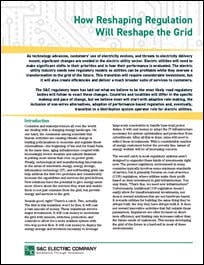S&C Electric Explores the Energy Regulation ‘Road’ to the Future Grid
Energy use isn’t static. Trends change with the times — and new technology. A new white paper from S&C Electric asserts that significant changes are needed in the electric utility sector, especially when it comes to energy regulation, as climate-change related natural disasters and power outages increase.
Download the full report.
Part of this shift will include changes within electric utilities themselves. Electric utilities will need to make significant shifts in their priorities and in how their performance is evaluated, S&C writes.
To ensure a smooth transition to the “grid of the future” — arguably one that is much more distributed — the electric utility industry will need to define regulatory models that suit this new environment.
S&C Electric notes in the report, “How Reshaping Regulation Will Reshape the Grid” that while this transition will require considerable investment, it will also likely create a more efficient grid and allow for a broader range of services for customers.
As this “future grid” takes shape, regulatory bodies can take steps to meet electric consumers where they are.
What’s the first step? According to S&C, “Countries and localities will differ in the specific makeup and pace of change, but we believe most will start with adaptive rate-making, the inclusion of non-wires alternatives, adoption of performance-based regulation and, eventually, transition to a distribution system operator role for electric utilities.”
Regardless of how this proposed transition plays out, it’s evident we are in the midst of a changing energy landscape. There are two main factors at play here, S&C points out:
“On one hand, the consensus among scientists that human activities are causing climate change is leading policymakers to monetize and regulate those externalities — the beginning of the end for fossil fuels,” the report states.
And secondly, there is the threat of aging infrastructure, as well as more severe weather and natural disasters putting pressure on our power grids.
New technology and manufacturing innovations in areas like renewable energy, energy storage, information technology (IT) and self-healing grids can help address these, but challenges remain. These include vast costs, as well as the fact that regulatory systems may have to shift to address and embrace these options.
Download the new report, “How Reshaping Regulation Will Reshape the Grid,” courtesy of S&C Electric, to explore what the future grid will look like and one path the electric and utility industry could take to navigate the transition from an energy regulation perspective.

